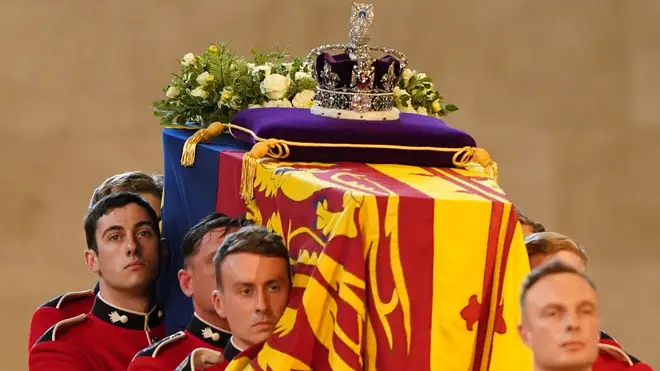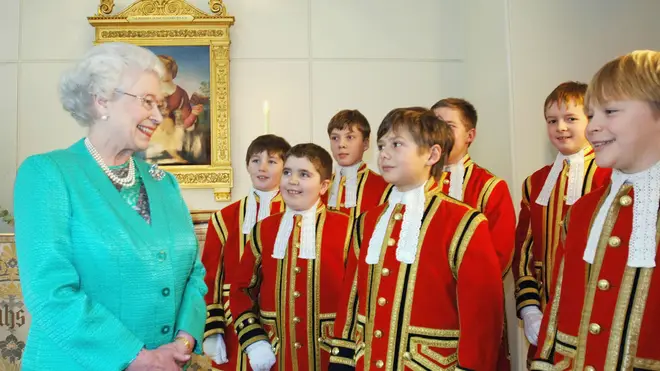The Queen’s funeral: how music moved a nation at Westminster Abbey and beyond
19 September 2022, 14:04 | Updated: 5 February 2024, 17:22

Queen Elizabeth II’s funeral took place on Monday 19 September 2022 at Westminster Abbey. Here’s everything you need to know about the music.
Listen to this article
On Monday 19 September, a historic ceremony took place at Westminster Abbey in honour of Queen Elizabeth II.
It was the first State Funeral in the United Kingdom for over 50 years, the last being for former Prime Minister Sir Winston Churchill in January 1965.
Following the historic ceremony, which began at 11am, Her Majesty’s coffin makes its way to Windsor Castle, where she will be buried with her husband, the late Duke of Edinburgh.
But what music has accompanied Her Majesty as she makes the last two journeys to her final resting place? Here’s all the music that has been chosen to celebrate the late Queen and her monumental 70 years of service.
Read more: Queen Elizabeth II’s funeral: All the music that will be played during the service

Troops rehearse for Queen's state funeral in London
What happened at Queen Elizabeth II’s funeral?
On Monday, the late Queen’s coffin was transported on the State Gun Carriage of the Royal Navy, drawn by 142 sailors, from Westminster Hall to Westminster Abbey.
The procession was led by 200 musicians, made up of the pipes and drums of Scottish and Irish regiments, the Brigade of Gurkhas and the Royal Air Force.
His Majesty King Charles III and other members of the royal family walked behind on the short journey to the Gothic abbey church.
Read more: The music for The Queen’s committal service at St George’s Chapel

Chorus greets coffin of Queen Elizabeth II as it is brought into Westminster Hall
What music was played at Queen Elizabeth II’s funeral?
The service was led by the Dean of Westminster, with music sung by The Choir of Westminster Abbey and The Choir of His Majesty’s Chapel Royal.
The choirs were led by Westminster Abbey’s Organist and Master of the Choristers, James O’Donnell, and the organ was played by the Abbey’s sub-organist, Peter Holder.
Prior to the start of the service, Westminster Abbey’s Assistant Organist, Matthew Jorysz, played a selection of works for the organ including pieces by Ralph Vaughan Williams, Orlando Gibbons, Harold Darke, and Peter Maxwell Davies. Holder then performed two pieces of Edward Elgar before the Procession of Religious Representatives moved into place.
Read more: The State Funeral of Her Majesty Queen Elizabeth II: How to listen

‘The Lord is My Shepherd’, sung by soprano Alexandra Stevenson
During the ceremony, the congregation joined in singing three hymns; ‘The day Thou gavest Lord is ended’, ‘The Lord’s my Shepherd’ and ‘Love Divine, All Loves Excelling’.
With the congregation seated, the choir performed the anthem, ‘My soul, there is a country’ by the English composer, Sir Hubert Parry.
Two new pieces written for the ceremony were also performed by the choir; a setting of a text from the New Testament’s Epistle to the Romans by Scottish composer, Sir James MacMillan, and ‘Like as the Hart’, an unaccompanied musical setting of Psalm 42 from the Book of Common Prayer by British composer, and Master of the King’s Music, Judith Weir CBE.
Weir explained ahead of the ceremony that Her Majesty’s “strong faith in, and support of, Anglican worship was an inspiration” when setting the psalm to music.
Speaking to Moira Stuart for the third series of Moira Stuart Meets... on Classic FM the evening before Her Majesty’s funeral, Weir told Stuart that the ceremony will be, “a beautifully performed occasion... even as a musical experience”.
Read more: Leading British orchestras and choirs pay tribute to the late Queen Elizabeth II through music

Moira Stuart speaks to Master of the King's Music, Judith Weir
Towards the end of the one-hour service, the ceremony drew to a close with the sounding of the Last Post followed by a national two-minute silence to be held shortly before midday for Her Majesty. The congregation then sang the national anthem, ‘God Save the King’.
As the anthem finished, The Queen’s Piper, Warrant Officer Class 1 (Pipe Major) Paul Burns, played, ‘Sleep, dearie, sleep’ a traditional Lament.
With the coffin and procession leaving the church, Holder returned to the organ to perform Johann Sebastian Bach’s ‘Fantasia in C minor’.
Read more: A guide to Queen Elizabeth II’s contribution to classical music and the arts

Charles appears moved as MPs sing God Save The King in Westminster Hall
Why was the music chosen?
The first hymn of the ceremony, ‘The day thou gavest, Lord, is ended’, written by the Anglican hymnodist the Rev John Ellerton, is significant in its origins; as the British Monarch is the head of the Church of England, music from the Anglican musical tradition was predicted to play a large role in today’s funeral programme.
In a 2016 radio documentary, Queen Elizabeth II’s top ten favourite songs were revealed, and among them were two Christian hymns, one of which was ‘The Lord’s my Shepherd’, a hymn based on Psalm 23 from the Bible’s Book of Psalms.
In the hymn, God is the named ‘shepherd’ and the text describes us as his ‘flock’ whom he is protecting.
The hymn was also played at Her Majesty’s wedding, and most recently, was performed at a thanksgiving service honouring the late Queen’s 70-year reign at St Giles’ Cathedral in Edinburgh.
Read more: The Lord’s my Shepherd: what are the lyrics for the hymn and who wrote the music?

‘The day thou gavest, Lord, is ended’ – the much-loved hymn sung in tribute to Queen Elizabeth II
Who performied at Queen Elizabeth II’s funeral?
The Choir of Westminster Abbey, led by musical director, James O'Donnell, sang during the Queen’s service.
Founded in the late 14th century, the world-renowned, all-male choir is made up of 30 boys, who all attend the Abbey’s Choir School, and 12 professional adult singers, known as Lay Vicars.
The choir was joined by The Choir of His Majesty's Chapel Royal, who previously sang alongside the Abbey’s singers when the Queen’s coffin was brought to lie in state at Westminster Hall on Wednesday 14 September.
The Choir of His Majesty's Chapel Royal is based at St James’ Palace and its history can be traced back to the 15th century.
Several famed composers have been members of the choir over the centuries, including Henry Purcell, Thomas Tallis, and William Byrd.
Read more: Music at Westminster Abbey – who are the choir members and organists?

What music was played at the ceremonial procession to Windsor Castle?
As Her Majesty’s coffin was transported from Westminster Abbey to Windsor Castle in the ceremonial procession, The Massed Pipes and Drums from Scottish and Irish Regiments, the Brigade of Gurkhas and the Royal Air Force band accompanied the moment with five well-known classical funeral marches.
Beethoven’s Funeral Marches No. 1, 2, and 3, Mendelssohn’s Funeral March, and Chopin’s Funeral March set the mournful tone of the procession, which crowds of people gathered to watch.
As Her Majesty’s coffin approached the Windsor gates, the Pipes and Drums band also played the traditional 19th-century Scottish ‘Skye Boat Song’.

London Symphony Orchestra play national anthem to honour the Queen
What happens after Queen Elizabeth II’s funeral?
The Queen’s coffin will be taken to St George’s Chapel at Windsor Castle for a committal service at 4pm.
A committal service is a Christian ritual which can include poems, prayers, and music, as a way for loved ones to say goodbye before the deceased is buried.
The service will be sung by the Choir of St George’s Chapel, conducted by James Vivian, Director of Music. The organ will be played by Luke Bond, Assistant Director of Music.
Read more: The music for The Queen’s committal service at St George’s Chapel at Windsor Castle
When the late Queen’s coffin is lowered into the Royal Vault, the Queen’s Piper, Pipe Major James M. Bank, will play a Lament.
Later that evening, a Private Burial will take place in The King George VI Memorial Chapel conducted by the Dean of Windsor for members of Her Majesty’s family.


































